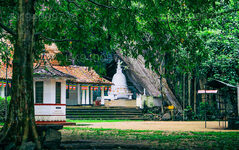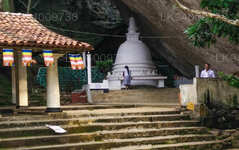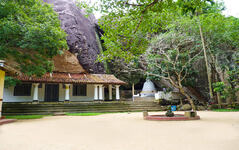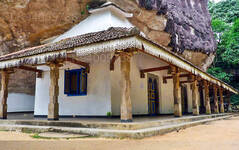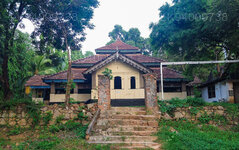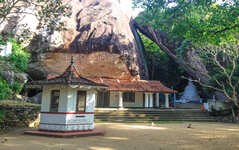
Gampaha City
Gampaha: Urban city in Sri Lanka with a mix of modern amenities and cultural heritage, including historic temples, bustling markets, and scenic landscapes.
Pilikuththuwa Raja Maha Viharaya
About Pilikuththuwa Raja Maha Viharaya
Pilikuththuwa is a cave temple in Sri Lanka with a millennia-long history. It saw great use from the 3rd century BC to the Dutch period in our recent past. The temple has almost a hundred caves spread over a space of approximately 200 acres. Amongst these 84 caves have been identified, fully explored and numbered. The cave temple is now a protected archaeological site in Sri Lanka.
Location
The temple is located in the region of Pilikuththuwa; just 30 miles from Colombo, in the Gampaha district. It can be reached by traveling to point just off Yakkala on the Colombo-Kandy highway. The temple itself on a rocky hill; while all around are beautiful paddy fields, rich stands of coconut cultivations, and dense green forests. As such, vibrant nature around the temple is host to a myriad of species. These include mammals such as the Ring-Tailed Civet, Palm Cat, Barking Deer and Sri Lankan Mongoose; bird species such as the Red Wattled Lapwing, Spotted Dove, Red-Vented Bulbul, Asian Koel, Small Bee-Eater, Magpie Robin, Hanging Parrot and Green Wood Pigeon; and a number of butterflies such as the Grey Pansy, Blue Bottle, Common Mormon, Blue Mormon, Common Sailor and White Four-ring; and a number of reptiles and amphibians.
History and Legend
Several legends and stories surround the Cave Temple of Pilikuththuwa. The main ones are regarding the odd name of the region. According to the most famous of these legends the name ‘Pilikuththuwa’ came from the era of King Valagamba from the 1st century BC. According to the story the King took refuge in one of the caves while fleeing the Indian Chola army who invaded his kingdom. It is believed that the King used these caves as a hideout while gathering his army. Later some of the caves were used by the King and Queen to store their royal garments. This apparently resulted in the area being called ‘Pili’ – Garments – ‘kuththuwa’.
Another story speaks of a more large scale matter. The area was supposed to have been divided in five divisions long ago; Pili Kotuwa, Arachchi Kotuwa, Mal Kotuwa, Halpath Kotuwa and Biligaha Kotuwa. However, with time the divisions combined to a single large region and the other four names disappeared; only the name Pili Kotuwa remained. This name then got changed with the accents of the millions who went on to live and pass through this space, until it became ‘Pilikuththuwa’.
It is said that the monastic presence in the caves began many centuries before Christ; when King Devanampiyatissa dedicated the cave complex to the Buddhist Sangha (sect). The monks built a large temple adjoining the cave and lived within many of them. It is said that the caves were also a refuge when King Rajasingha I, who ruled Sitawaka, persecuted Buddhist monks in the 16th century due to his Anti-Buddhist views. In addition, there are signs of Portuguese, Dutch and British influence within the caves as well.
The Caves
During the Stone Age the caves of Pilikuththuwa were used as living space by the civilizations of the time as has been proved by artifacts found in some of the caves. It is unknown that whether the drip ledges (overhanging ledges carved along the top of cave entrances to prevent water dripping and penetrating the insides of the caves) were carved at this time or afterwards when they were used by Buddhist monks. Some of the ledges also have Brahmi characters carved along the ledges, believed to have been made between the 2nd and 3rd centuries BC.
Each of the caves and the surroundings have something interesting to see; such as the Image house with its Portuguese soldier paintings and lotus flower painted ceiling with the 12 star signs, the Dharmasala (sermon hall), the old clay Chaithya, the ‘Prince’ and ‘Princess’ Sacred Bo Trees, the Bathing well within the caves, the Dutch era wooden bridge, the Hat Cave with its top hat shaped hole, the Bell arch located on a large boulder, the small upper temple with more paintings, and much more. One of the most interesting objects is an old wooden palanquin. It is said that it was said to have been used by an influential monk centuries ago when he travelled to the Temple. When he left he is supposed to have used a cart and therefore left his palanquin there. In any case all these sights add to the olden-day charm and allure of the Pilikuththuwa Cave Temple.
As such the temple provides a very gratifying visual experience that will not be forgotten easily.
About Gampaha District
Gampaha is an urban city in Sri Lanka and is the capital of the Gampaha District in Western Province, north of Colombo. Gampaha District is separated from Colombo mainly by the Kelani River. Gampaha town is about 4km from Miriswatta on Colombo-Kandy road. Gampaha is surrounded by Yakkala, Miriswatta, Weliweriya Udugampola and Ja-Ela towns.
The name "Gampaha" in Sinhala literally means Five Villages. The five villages are known to be Ihalagama, Pahalagama, Medagama, Pattiyagama and Aluthgama.
About Western Province
The Western Province is the most densely populated province of Sri Lanka. It is home to the legislative capital Sri Jayawardenapura as well to Colombo, the nation's administrative and business center. Western Province is divided into 3 main districts called Colombo (642 km²), Gampaha (1,386.6 km²) and Kalutara (1,606 km²) districts. As Sri Lanka's economic hub, all the major local and international corporations have their presence in the city and so do all the major designer and high street retailers, so be ready to indulge in some retail therapy in western province.
Having the highest population in the all the provinces, the almost all the premier educational institutions in the island are located in western province. Universities in the province include the University of Colombo, the University of Sri Jayewardenepura, University of Kelaniya, Open University, Sri Lanka, Buddhist and Pali University of Sri Lanka, General Sir John Kotelawala Defence University and University of Moratuwa .Western province has the largest amount of schools in the country, which includes National, Provincial, Private and International schools.
【Text by Lakpura™. Images by Google, copyright(s) reserved by original authors.】

